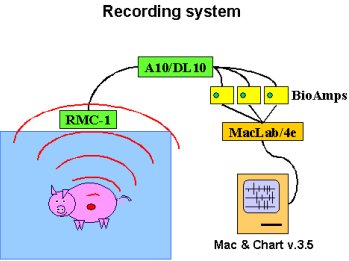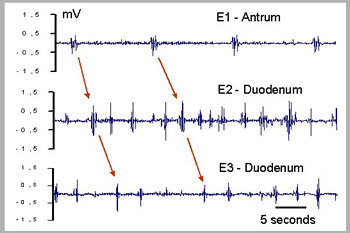Why Gastrointestinal Telemetry in the Pig?
The scientific interest of our research team is focused on the development of the gastrointestinal tract and its neurohormonal regulation in young mammals, in particular piglets and calves. We investigate how gastrointestinal tract motility, secretion and absorption are modified with age and by dietary factors (colostrum-milk-solid food). This basic physiological information helps us to look for possible ways to minimize gastrointestinal disorders; this is a serious economical problem in the pig industry in particular. That is why pigs, sucklings and weaned, are used in our studies. Moreover, the pig is also used as an animal model for humans, in particular for infants because of the numerous digestive tract similarities. The complex gastrointestinal function entails mixing, passage of digesta, and motility. In general, gut contractile activity is well reflected by its myoelectrical activity. In continual experiments we measure gastrointestinal motility indirectly by recording pressure changes in the gastrointestinal tract lumen (balloon method) and directly by recording muscle contractile activity via implanted strain gages. Recording myoelectrical activity via implantable serosal electrodes is the method used most often since it is simple and reliable. Until the application of telemetry in research possible, we faced problems related to the tubes and cables surrounding the experimental animals. All those who use telemetry in research know that telemetry helps maintain the experimental animal in good health (no ascending inflammation, plug loss, etc.), this is borne out by our piglets. Moreover piglets usually accept the catheters, plugs and cannulas in their bodies as long as they can move freely in their cages; they do not accept them when restrained for recording and plugged to the extension wires and tubes. Pigs are clever animals, so it is possible sometimes for them to learn or grow accustomed to the recording procedure after several days of training. However, this does not apply to the 'dominant pig' in the litter-the telemetric approach actually helps eliminate these problems. We can either record pigs in individual cages or any of the piglets kept together with the litter in a large cage. This is particularly interesting for nutritional studies.

Recording system assembly for gastrointestinal smooth muscle electromyography in pig. RMC-1 - telemetry receiver; A10/DL10 - analog output; BioAmps and MacLab/4e - data recording system from ADInstruments.
Details on surgery and recording of gastroduodenal myoelectrical activity have been published. Piglets are implanted with silicone based silver bipolar electrodes that are soldered to the lead wires supported by the D70EEE implant. The implant is fixed extraperitoneally in a pocket made between the muscle layers on the lower right part of the abdomen. Recording is done via a receiver (RMC-1), analog output (DL10), preamplifiers and a/d converter (BioAmps and MacLab/4e, ADInstruments, Melbourne, Australia) and computer. The recorded signals are analysed off-line (Chart v3.5, ADInstruments).

Representative trace of the antral and duodenal myoelectrical activity in a pig. Recorded by telemetry. Arrows indicate spike migration.
To learn more about the use of telemetry in research contact Romuald Zabielski and Wojciech Korczynski at the Kielanowski Institute of Animal Physiology and Nutrition, Polish Academy of Sciences, 05-110 Jablonna, Poland, e-mail:infizyz@atos.warman.com.pl
The effect of encapsulated acidifiers on antroduodenal myoelectrical activity in pigs. Gacsalyi U. Korczynski W. Zabielski R. Pierzynowski S.G. 8th Symposium on Digestive Physiology in Pigs 2000
Telemetry facilitates long-term recording of gastrointestinal myoelectrical activity in pigs. Gacsalyi U. Zabielski R. Pierzynowski S.G. Experimental Physiology 85 239-241